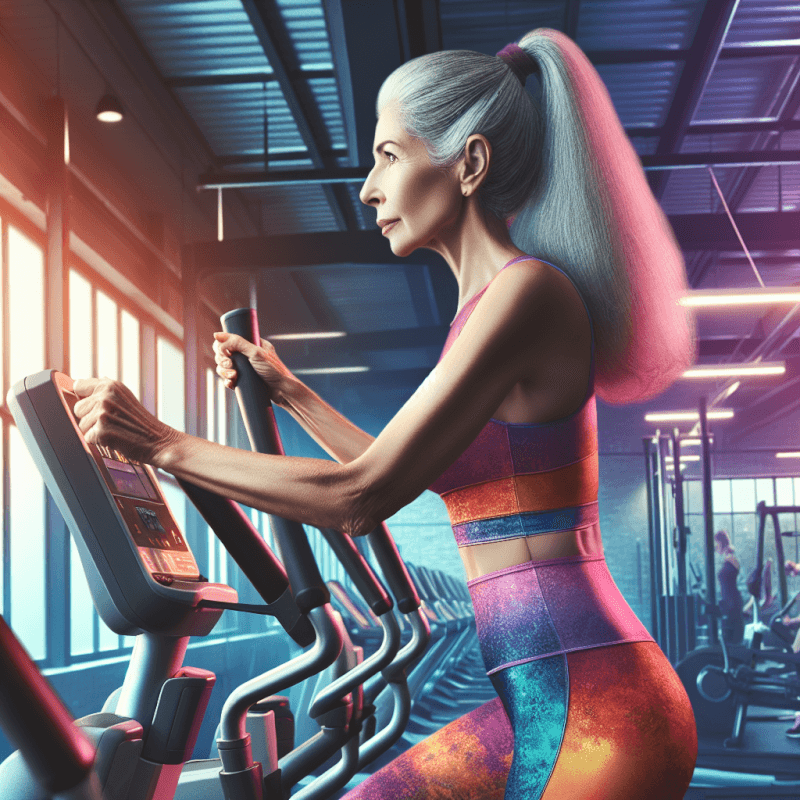Congratulations on reaching 50 and embracing a new chapter in your life! As we age, it becomes even more important to take care of our physical health, and exercise plays a crucial role in maintaining a strong and vibrant body. In this article, we will explore the best exercises specifically tailored for women over 50, helping you stay fit, flexible, and full of energy. Whether you’re a beginner or looking to switch up your routine, we’ve got you covered with exercises that are not only effective but also enjoyable. So, let’s dive right in and discover the perfect workout regimen to keep you feeling incredible in your prime years!
Strength Training
Strength training is a fantastic way for women over 50 to improve their overall health and well-being. Not only does it help build muscle and increase bone density, but it also offers numerous other benefits. By incorporating strength training into your fitness regimen, you can enhance your metabolism, boost your energy levels, and increase your overall strength and endurance.
Benefits of Strength Training
There are several advantages that women over 50 can experience through strength training. Firstly, it helps to prevent age-related muscle loss, known as sarcopenia, which can lead to weakness and decreased mobility. By engaging in regular strength training exercises, you can counteract this natural decline in muscle mass, maintain your independence, and perform daily activities with ease. Additionally, strength training has been shown to improve sleep quality, enhance cognitive function, and alleviate symptoms of depression and anxiety.
Types of Strength Training Exercises
There are different types of strength training exercises that you can incorporate into your fitness routine. Resistance training using free weights, resistance bands, or weight machines is an excellent option to target specific muscle groups. Bodyweight exercises, such as push-ups, squats, and lunges, can also be effective in building strength and improving balance. Another popular choice is strength training using stability balls, which not only challenges your muscles but also helps improve core stability.
Recommended Frequency and Duration
For women over 50, it’s recommended to engage in strength training exercises two to three times per week, allowing for a day of rest in between to give your muscles time to recover. Each session should ideally focus on all major muscle groups, including the chest, back, legs, shoulders, arms, and core. Aim for 8-12 repetitions of each exercise, gradually increasing the weight or resistance as you become stronger. It’s essential to maintain proper form and listen to your body to prevent injury.
Tips for Getting Started
If you’re new to strength training or haven’t exercised in a while, it’s crucial to start slowly and gradually increase the intensity and duration of your workouts. Begin with lighter weights or resistance bands and focus on mastering proper technique before progressing to heavier loads. It’s also essential to warm up before each strength training session to prepare your muscles and joints for the workout. Stretching after your workout can help improve flexibility and reduce muscle soreness. Don’t hesitate to seek guidance from a qualified fitness professional to ensure you’re performing exercises correctly and safely.
Cardiovascular Exercises
Cardiovascular exercises play a vital role in maintaining a healthy heart and overall cardiovascular health, especially for women over 50. Engaging in regular cardio exercises can help lower the risk of heart disease, increase lung capacity, and improve overall stamina. It also aids in weight management, reduces stress levels, and enhances mood and mental well-being.
Importance of Cardiovascular Exercises
As women age, the risk of developing heart disease increases. Incorporating cardiovascular exercises into your fitness routine can minimize this risk by improving heart health. Regular aerobic workouts help strengthen the heart muscle, lower blood pressure, and reduce levels of bad cholesterol. Engaging in cardio exercises also promotes the circulation of oxygen and nutrients throughout the body, improving overall cardiovascular function and reducing the likelihood of blood clot formation.
Low-Impact Options
For women over 50, low-impact cardio exercises are a great way to reap the benefits of aerobic activity while minimizing the stress on joints and reducing the risk of injury. Options such as walking, swimming, and cycling are excellent low-impact choices. These activities provide a cardiovascular workout without placing excessive strain on the knees, hips, and ankles. Water exercises, such as water aerobics or aqua jogging, are particularly beneficial for those with joint pain or arthritis due to the buoyancy of the water reducing impact.
High-Intensity Interval Training (HIIT)
High-Intensity Interval Training, commonly known as HIIT, is a form of cardiovascular exercise that involves short bursts of intense activity followed by periods of rest or lower-intensity movement. HIIT workouts are particularly appealing for women over 50 as they can be modified to accommodate individual fitness levels and physical abilities. Research has shown that HIIT can increase cardiovascular fitness, boost metabolism, and improve insulin sensitivity, making it an effective choice for weight management and overall health.
Choosing the Right Cardio Routine
When choosing a cardio routine, it’s important to consider your preferences, physical limitations, and overall fitness goals. Find an activity that you enjoy and one that you can incorporate into your lifestyle consistently. Whether it’s dancing, hiking, swimming, or using exercise machines, the key is to engage in activities that get your heart rate up and challenge you aerobically. Remember to start at a comfortable pace and gradually increase the intensity and duration. If you have any existing health conditions, it’s always best to consult with your healthcare provider before starting a new exercise program.

Flexibility and Balance Exercises
Maintaining flexibility and balance becomes increasingly important as women age. Flexibility exercises can help improve mobility, reduce muscle stiffness, and enhance joint range of motion. Incorporating balance exercises into your fitness routine is crucial for preventing falls and maintaining stability. By regularly practicing flexibility and balance exercises, women over 50 can enhance their overall quality of life and reduce the risk of injury.
Benefits of Flexibility and Balance Exercises
Flexibility exercises offer numerous benefits for women over 50. They can help alleviate muscle tension, improve posture, and increase blood flow to the muscles. Enhanced flexibility can also improve athletic performance, allowing for better range of motion during activities such as golf, tennis, or gardening. Balance exercises, on the other hand, are essential for preventing falls and promoting stability. As we age, our balance can naturally decline, making it more important than ever to engage in exercises that challenge and improve our balance.
Yoga and Pilates
Yoga and Pilates are popular choices for women over 50 to improve flexibility, balance, and overall body strength. Yoga combines a series of poses, breathing exercises, and meditation to promote physical and mental well-being. Its gentle movements and focus on breathing make it a suitable choice for individuals of all fitness levels. Similarly, Pilates focuses on core strength, muscle control, and body alignment through a series of controlled movements performed on a mat or using specialized equipment. Both disciplines help improve overall flexibility, balance, and body awareness.
Tai Chi and Qigong
Tai Chi and Qigong are ancient Chinese practices that involve slow, flowing movements and controlled breathing. These mind-body exercises are particularly beneficial for women over 50 as they enhance flexibility, improve balance, and promote relaxation and mental clarity. Tai Chi and Qigong can be practiced by individuals of all fitness levels and physical abilities, making them accessible and low-impact options for improving overall well-being.
Stretching and Balance Exercises
In addition to specific exercise disciplines, incorporating simple stretching and balance exercises into your daily routine can make a significant difference in improving flexibility and balance. Stretching exercises, such as hamstring stretches, shoulder stretches, and calf stretches, can help improve flexibility and relieve muscle tension. Balance exercises, such as standing on one leg or practicing heel-to-toe walking, can help strengthen your core muscles and improve stability. Remember to start slowly, hold stretches for 15-30 seconds, and perform balance exercises near a stable surface or with a chair for support.
Joint-Friendly Exercises
Engaging in joint-friendly exercises is essential for women over 50, as it allows for physical activity while minimizing stress on joints and reducing the risk of joint pain or injury. Incorporating exercises that are gentle on the joints into your fitness routine can help maintain joint flexibility, improve overall mobility, and alleviate arthritis symptoms.
Importance of Joint-Friendly Exercises
Joint-friendly exercises are particularly important for women over 50, as joint stiffness and discomfort can become more prevalent as we age. These exercises offer the opportunity to stay active and maintain joint health without exacerbating existing joint conditions. By engaging in low-impact activities, you can help reduce the risk of joint damage, manage pain and inflammation, and improve overall joint mobility.
Swimming and Water Aerobics
Swimming and water aerobics are excellent choices for joint-friendly exercises. The buoyancy of the water reduces the impact on joints, making it an ideal option for individuals with arthritis or joint pain. Swimming engages the entire body and provides a cardio workout while simultaneously strengthening the muscles. Water aerobics classes, on the other hand, combine cardiovascular exercise with resistance training using water as resistance, providing a full-body workout without joint stress.
Cycling and Stationary Biking
Cycling and stationary biking are low-impact exercises that are gentle on the joints while providing an excellent cardiovascular workout. Whether you prefer outdoor cycling or using a stationary bike indoors, this exercise helps strengthen leg muscles, improve cardiovascular fitness, and reduce stress on weight-bearing joints such as the knees and hips. Adjusting the seat height and distance can ensure proper alignment and reduce strain on the joints.
Elliptical Machine and Cross-Trainer
Using an elliptical machine or cross-trainer is another joint-friendly option that allows for a challenging cardio workout without placing excessive strain on the joints. These machines mimic the natural motion of walking or running while reducing impact, making them ideal for women over 50 who may have joint sensitivities. The elliptical machine also engages the upper body, providing a full-body workout that can help improve cardiovascular fitness and overall strength.

Core Strengthening Exercises
Building a strong core is essential for women over 50 as it helps improve stability, balance, and overall functional fitness. Strengthening the core muscles, which include the abdominal muscles, back muscles, and muscles around the pelvis, can aid in maintaining good posture, preventing lower back pain, and enhancing overall body strength.
Importance of Core Strength
Core strength is crucial for everyday movements, such as lifting objects, getting out of bed, or maintaining balance. As we age, maintaining strong core muscles becomes increasingly important to support the spine, improve posture, and reduce the risk of injury. Core strength also plays a role in improving athletic performance, whether it’s jogging, playing golf, or participating in group fitness classes.
Planks and Side Planks
Planks and side planks are effective exercises for targeting multiple muscles in the core. To perform a plank, start by getting into a push-up position but resting on your forearms instead of your hands. Engage your core, keeping your body in a straight line from your head to your heels. Hold this position for as long as you can, or start with shorter intervals and gradually increase the duration as you build strength. Side planks are performed in a similar manner, with the body supported on one forearm and the feet stacked on top of each other, engaging the obliques and strengthening the side muscles of the core.
Crunches and Sit-Ups
Crunches and sit-ups are classic core exercises that target the abdominal muscles. To perform a crunch, lie flat on your back with your knees bent and feet flat on the floor. Place your hands behind your head, engage your core, and slowly lift your upper body while keeping your lower back on the ground. Exhale as you lift and inhale as you lower back down. Sit-ups are similar to crunches but involve lifting the entire upper body to a seated position. These exercises can be modified based on fitness level, and it’s important to maintain proper form and avoid straining the neck or lower back.
Pilates and Yoga for Core Strength
Pilates and yoga are excellent exercise disciplines for building core strength. Pilates focuses on deep core muscles, using controlled movements and breathing techniques to engage the abdominals, back muscles, and pelvic floor. Many Pilates exercises can be performed on a mat or using specialized equipment such as the Pilates reformer. Yoga, on the other hand, incorporates poses that not only strengthen the core but also improve flexibility and overall body awareness. Poses such as Boat Pose, Plank, and Bridge Pose are all effective for targeting the core muscles and building strength.
Weight-Bearing Exercises
Weight-bearing exercises are essential for women over 50, as they help maintain strong bones and reduce the risk of osteoporosis. Engaging in weight-bearing exercises can help increase bone density, improve balance and coordination, and reduce the risk of fractures.
Benefits of Weight-Bearing Exercises
Weight-bearing exercises, also known as resistance exercises, put stress on the bones, which stimulates the body to build new bone tissue. This can help prevent bone loss and reduce the risk of osteoporosis, a condition that weakens bones and increases the likelihood of fractures. Regular weight-bearing exercises also improve muscle strength and help maintain healthy body weight, as they burn calories and increase metabolism.
Walking and Hiking
One of the easiest and most accessible weight-bearing exercises for women over 50 is walking. Walking on a regular basis not only provides cardiovascular benefits but also helps strengthen bones and build muscle. To maximize the bone-strengthening benefits, try incorporating uphill walks or hiking, which increases the load placed on the bones and stimulates bone growth in the lower body. Walking with proper posture, using comfortable footwear, and gradually increasing the duration and intensity of your walks can help reap the benefits of this simple yet effective exercise.
Dancing and Zumba
Dancing is not only a fun and enjoyable activity, but it’s also an excellent weight-bearing exercise. Whether you prefer ballroom dancing, salsa, or Zumba classes, dancing engages multiple muscle groups and puts stress on the bones, contributing to increased bone density. Dancing also improves balance, coordination, and cardiovascular fitness, making it an all-around beneficial exercise for women over 50.
Using Resistance Bands
Incorporating resistance bands into your strength training routine can provide weight-bearing benefits without the need for heavy weights or equipment. Resistance bands come in different resistance levels, allowing for gradual progression as your strength improves. These bands can be used to perform a variety of exercises targeting different muscle groups, providing both strength training and weight-bearing benefits. Incorporate exercises such as bicep curls, standing rows, and lunges using resistance bands to challenge your muscles and bones.

Functional Training
Functional training focuses on performing exercises that mimic everyday movements and improve overall functional fitness. For women over 50, functional training is particularly beneficial, as it can enhance mobility, strength, and balance, ultimately improving the ability to perform daily activities with ease.
Understanding Functional Training
Functional training aims to improve the body’s ability to perform activities of daily living by focusing on movements that integrate multiple muscle groups. This type of training emphasizes functionality rather than isolating individual muscles. By engaging in exercises that replicate real-life movements, such as squatting, bending, lifting, and twisting, women over 50 can improve overall strength, flexibility, and coordination, reducing the risk of injury and enhancing everyday functionality.
Examples of Functional Exercises
There are numerous functional exercises that women over 50 can incorporate into their fitness routine. Squats, for example, mimic the motion of sitting and standing, strengthening the leg muscles and improving overall lower body strength. Lunges engage multiple muscles of the lower body and improve balance and stability. Walking or jogging with a resistance band around the hips challenges the muscles used for forward movement and strengthens the hips and glutes. Other functional exercises include medicine ball throws, farmer’s walks, and seated rows using resistance bands.
Incorporating Everyday Movements
When designing a functional training routine, it’s important to incorporate exercises that mimic everyday movements. For example, instead of using weight machines or isolation exercises, opt for compound exercises that engage multiple muscle groups simultaneously. Squatting down to pick up an object from the floor, for instance, can be replicated by performing squats or deadlifts with weights. By incorporating exercises that relate directly to your daily activities, you can increase strength and improve overall functionality.
Benefits of Functional Training
Functional training offers several benefits for women over 50. By focusing on movements that replicate real-life activities, functional training helps improve overall strength, flexibility, and balance, making everyday tasks much easier to perform. Functional exercises work multiple muscle groups simultaneously and engage the core muscles, promoting better posture and alignment. Additionally, functional training can help prevent injuries by improving joint stability, reducing muscle imbalances, and increasing overall body awareness.
Mind-Body Exercises
Mind-body exercises emphasize the connection between the mind and body, promoting overall well-being and mindfulness. These exercises, such as yoga, meditation, tai chi, and qigong, can be particularly beneficial for women over 50, as they promote relaxation, reduce stress, and improve flexibility and balance.
Benefits of Mind-Body Exercises
Mind-body exercises offer a range of advantages for women over 50. Firstly, they provide an opportunity to reduce stress and promote relaxation, which can help improve sleep quality and overall mental well-being. Mind-body exercises also help enhance flexibility and balance, important aspects of physical fitness as we age. By combining physical movement with mindfulness and breathing techniques, these exercises promote a sense of calm, improve body awareness, and encourage a positive mindset.
Yoga and Meditation
Yoga and meditation are practices that have been used for centuries to promote a connection between the mind and body. Yoga combines physical postures, breathing exercises, and meditation, helping to improve flexibility, strength, and mental clarity. It offers various styles and levels of intensity, making it accessible to individuals of all fitness levels. Meditation, on the other hand, focuses on mindfulness and cultivating a calm and focused state of mind. Both yoga and meditation can help reduce stress, improve mental well-being, and enhance overall body awareness.
Tai Chi and Qigong
Tai Chi and Qigong are ancient Chinese practices that focus on slow, flowing movements, controlled breathing, and meditation. These mind-body exercises are particularly beneficial for women over 50, as they can improve flexibility, balance, and overall strength. Tai Chi and Qigong can be practiced at various intensities, making them suitable for individuals of all fitness levels. These practices promote relaxation, reduce stress, and enhance body awareness and mindfulness.
Breathing Techniques
Incorporating specific breathing techniques into your exercise routine can have a profound impact on overall well-being. Deep breathing exercises, such as diaphragmatic breathing or belly breathing, can help promote relaxation, reduce stress, and lower blood pressure. These techniques involve inhaling deeply through the nose, allowing the belly to expand, and exhaling fully through the mouth. Breathing exercises can be performed as standalone practices or incorporated into other mind-body exercises such as yoga or meditation.

Group Fitness Classes
Group fitness classes are a fantastic way for women over 50 to stay motivated, have fun, and improve overall fitness. Participating in group exercise provides a sense of camaraderie, support, and accountability, making it easier to stick to a regular exercise routine and achieve your fitness goals.
Benefits of Group Fitness Classes
Group fitness classes offer numerous benefits for women over 50. Firstly, they provide an opportunity to try new exercises and challenge yourself in a supportive environment. Group classes offer a variety of formats, such as aerobics, dance, strength training, and mind-body exercises, catering to different interests and fitness levels. Attending group classes can also help improve social connections and combat feelings of isolation that sometimes accompany aging. Additionally, exercising in a group setting can be motivating and inspiring, encouraging you to push yourself further and reach new fitness milestones.
Aerobics and Dance Classes
Aerobics and dance classes are popular choices for group fitness, offering a fun and energetic workout while improving cardiovascular health. Aerobics classes typically involve choreographed movements set to music, providing a full-body workout that incorporates both cardiovascular and strength training elements. Dance classes, such as Zumba or hip-hop, provide a unique combination of cardio workout and dance routines, making exercise feel more like a dance party. Both aerobics and dance classes allow women over 50 to enjoy the benefits of group fitness while grooving to the beat.
Strength Training Classes
Strength training classes are an excellent option to improve overall strength, enhance muscle tone, and increase bone density. These classes often incorporate free weights, resistance bands, or weight machines to target specific muscle groups. Instructors guide participants through a series of exercises, ensuring proper form and technique. Strength training classes offer a motivating and energetic environment that encourages participants to challenge themselves and achieve their strength goals. Whether it’s a full-body strength class or a focused session targeting specific muscle groups, there are options available for women of all fitness levels.
Finding the Right Class for You
When selecting a group fitness class, it’s essential to find one that aligns with your interests, goals, and fitness level. Consider the type of exercise you enjoy and the specific benefits you want to achieve. If you’re new to group fitness or have any underlying health conditions, it’s advisable to start with low-impact options such as water aerobics or beginner-level classes. Take advantage of trial classes or introductory offers to explore different formats and determine which classes resonate with you and your fitness goals. Don’t be afraid to try something new and step out of your comfort zone – you might just discover a new passion!
Guidelines for Exercising Safely
Exercising safely is of utmost importance, especially for women over 50 who may have specific considerations or underlying health conditions. By following certain guidelines and precautions, you can reduce the risk of injury and ensure a safe and enjoyable exercise experience.
Consulting with a Healthcare Professional
Before starting a new exercise program, it’s crucial to consult with a healthcare professional, particularly if you have any chronic health conditions or concerns. Your doctor can assess your overall health and provide tailored recommendations based on your individual needs and limitations. They can also advise on any modifications or precautions you should take to exercise safely. With their guidance, you can create an exercise plan that suits your specific goals and ensures your safety.
Warming Up and Cooling Down
Before each exercise session, it’s essential to warm up your muscles and prepare your body for physical activity. A proper warm-up typically includes gentle movements that increase heart rate and blood flow, such as walking, light jogging, or dynamic stretching. Warming up gradually raises body temperature and loosens the muscles, reducing the risk of injury. Similarly, cooling down after exercise is important to gradually bring your heart rate back to its resting state and prevent sudden blood pressure drops. A cool-down can include low-intensity exercises, such as walking or stretching, and promotes recovery and flexibility.
Listening to Your Body
Listening to your body is key to exercising safely and avoiding overexertion or injury. Pay attention to any warning signs, such as pain, dizziness, or shortness of breath, and modify or stop the exercise if necessary. If you experience persistent pain or discomfort during or after exercise, it’s essential to consult with a healthcare professional to identify the underlying cause and take appropriate action.
Staying Hydrated and Eating Well
Proper hydration and nutrition are essential components of exercising safely and maintaining overall health. When engaging in physical activity, it’s important to drink an adequate amount of water before, during, and after your workout to stay hydrated. Dehydration can lead to fatigue, dizziness, and reduced performance. Additionally, maintaining a well-balanced diet that includes a variety of nutrient-rich foods, such as fruits, vegetables, lean proteins, and whole grains, provides the necessary fuel for your body to perform optimally during exercise. Consult with a registered dietitian or nutritionist to ensure you’re meeting your individual nutritional needs.
In conclusion, incorporating a variety of exercises into your fitness routine can provide numerous benefits for women over 50. Strength training helps build muscle and increases bone density, cardiovascular exercises improve heart health and overall stamina, flexibility and balance exercises enhance mobility and stability, joint-friendly exercises reduce joint pain and increase overall mobility, core strengthening exercises improve stability and functional fitness, weight-bearing exercises increase bone density and strength, functional training improves everyday functionality, mind-body exercises promote relaxation and mindfulness, and group fitness classes provide motivation and camaraderie. Following guidelines for exercising safely, such as consulting with a healthcare professional, warming up and cooling down, listening to your body, and staying hydrated and eating well, are crucial for a safe and enjoyable exercise experience. Remember, it’s never too late to start or continue your fitness journey, and with the right approach, exercise can enhance your quality of life well into your 50s and beyond.



